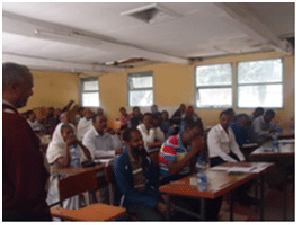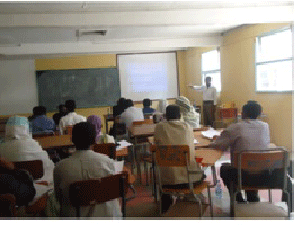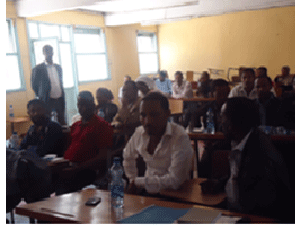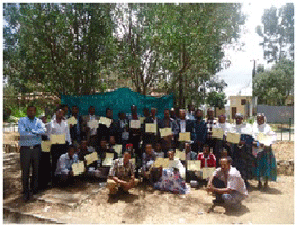Research Article Open Access
Capacity Buildings of Traditional Medicine Practitioners’ as a Primary Health Care Workers in Gondar Town, Northwest Ethiopia
| Abyot E1*, Zewdu B1, Tefera A2, Mohammedberhan AW2 and Mulugeta F3 | |
| 1Department of Pharmacognosy, School of Pharmacy, College of Medicine and Health Sciences, University of Gondar, Ethiopia | |
| 2Department of Pharmacology, School of Pharmacy, College of Medicine and Health Sciences, University of Gondar, Ethiopia | |
| 3Department of Pharmaceutics, School of Pharmacy, College of Medicine and Health Sciences, University of Gondar, Ethiopia | |
| Corresponding Author : | Abyot E Department of Pharmacognosy, School of Pharmacy College of Medicine and Health Sciences University of Gondar, Ethiopia Tel: 251-913-39-99-86 E-mail: abyot.endale@gmail.com |
| Received March 17, 2014; Accepted April 15, 2014; Published April 17, 2014 | |
| Citation: Abyot E, Zewdu B, Tefera A, Mohammedberhan AW, Mulugeta F (2014) Capacity Buildings of Traditional Medicine Practitioners’ as a Primary Health Care Workers in Gondar Town, Northwest Ethiopia. J Homeop Ayurv Med 3:151. doi: 10.4172/2167-1206.1000151 | |
| Copyright: © 2014 Abyot E, et al. This is an open-access article distributed under the terms of the Creative Commons Attribution License, which permits unrestricted use, distribution, and reproduction in any medium, provided the original author and source are credited. | |
Visit for more related articles at Journal of Traditional Medicine & Clinical Naturopathy
Abstract
Background: Traditional medicine has a crucial role in building the health system in developing country. The World Health Organization also recognized traditional medicine as a vital health-care resourcein developing countries and has encouraged governments to adopt policies to officiallyacknowledge and regulate the practice of traditional medicine. Moreover, many of the pharmaceutical products used in modern medicine, have directly or indirectly derived from the knowledge of traditional medicine. However, in many countries,including Ethiopia, there is acritical lack of cooperation between conventional and traditional medicine practitioners. Objective: This project was aimed to enhance the capacity of traditional health practitioners’ as primary health workers in the aforementioned town for the betterment of qualityservices to the community. Implementation: As the project was new, we were used participatory methods. Prior to actual training, half day sensitization meeting was held with respective stake holders. A total of 28 traditional health practitioners’ were trained for five consecutive days, from May 08 to 12, 2013. During these days, topics such as global situation of traditional medicine, methods of herbal drug preparation, cultivation and sustainable use of medicinal plants, acquisition of traditional medical knowledge, HIV care and prevention, handling and referring of patients, regulation and ethics in traditional medicine were intensively discussed. Apart from the training, mortar and pestle and measuring cylinder was also given for each trainee. Project output: During evaluative research in January 2014, significant improvement in quality of traditional medicine practice in Gondar town was obtained. All trained healers uses mortar and pestle for preparation of potions. Majority (75%) started cultivation of medicinal plants at their home. Trained traditional healers gained knowledge on the health and traditional medicine policy of Ethiopia. Increased positive attitude towards ethical principle and patient handling were also obtained. Conclusion: The practitioners’ are eager to adopt standard methods and willing to collaborate with modern medicine. It is therefore desirable to extend such type of project nationally for better health.
Objective: This project was aimed to enhance the capacity of traditional health practitioners’ as primary health workers in the aforementioned town for the betterment of quality services to the community.
Implementation: As the project was new, we were used participatory methods. Prior to actual training, half day sensitization meeting was held with respective stake holders. A total of 28 traditional health practitioners’ were trained for five consecutive days, from May 08 to 12, 2013. During these days, topics such as global situation of traditional medicine, methods of herbal drug preparation, cultivation and sustainable use of medicinal plants, acquisition of traditional medical knowledge, HIV care and prevention, handling and referring of patients, regulation and ethics in traditional medicine were intensively discussed. Apart from the training, mortar and pestle and measuring cylinder was also given for each trainee.
Project output: During evaluative research in January 2014, significant improvement in quality of traditional medicine practice in Gondar town was obtained. All trained healers uses mortar and pestle for preparation of potions. Majority (75%) started cultivation of medicinal plants at their home. Trained traditional healers gained knowledge on the health and traditional medicine policy of Ethiopia. Increased positive attitude towards ethical principle and patient handling were also obtained.
Conclusion: The practitioners’ are eager to adopt standard methods and willing to collaborate with modern medicine. It is therefore desirable to extend such type of project nationally for better health.
Others consider that it is “medicine based on beliefs and cultural practices, handed down from one generation to another. It includes mystical and magic rites, herbal and other treatments that cannot be explained by modern medicine.
According to the figures provided by WHO in the Report on The World Medicines Situation [2], between 70% and 95% of citizens in many developing countries use traditional medicine for the management of health and as a primary source of health care. This is explained, in most cases, either because they simply have no alternative choice, depending first and foremost on difficulty in gaining access to different and more expensive kinds of treatment, or because of cultural tradition. They turn to traditional medicine mainly because it is close at hand, easily affordable, readily available, cheap and consistent with indigenous cultures or ethnic group, though its effectiveness needs proving.
In sub-Saharan Africa for example, 85% of the population go to traditional healers. In Ghana, Mali, Nigeria and Zambia, herbal medicines are administered at home as first-aid treatment for 60% to children with high fever caused by malaria [3].
At the same time, however, the spread of traditional medicine in some industrialized countries is equally significant. In this case, the term is often used as a synonym for a large body of health care practices which have been set apart because they differ from the methods and treatments normally taught in medical faculties, as well as products which can be purchased under very different names, often without prescription and simply over-the-counter in shops other than pharmacies: for example, dietary supplements, functional foods, and self-medication products. Countries like Canada, France, Germany and Italy report that between 70% and 90% of their population have used traditional medicines, either because of the persuasion that this kind of treatment is more “natural” and therefore “danger-free”, or as a supplement for chronic, debilitating or incurable diseases [4]. More than 50% of the population in these countries has used traditional medicine at least once. For example, in China, traditional herbal preparations account for 30%-50% of total medicinal consumption. In Canada, 70% of the populations have used parallel medicine at least once. In Germany, 90% of the population has used a natural remedy at some point in their life [3,5]. Many Americans use complementary and alternative medicine (CAM) in pursuit of health and well-being. The 2007 National Health Interview Survey (NHIS), which included a comprehensive survey of CAM use by Americans, showed that approximately 38 percent of adults use CAM [6].
Herbal products are often used as a first line therapy for conditions such as benign prostatic hyperplasia (BPH) in Germany, Italy, and elsewhere. German physicians receive medical school training in medicinal herbs and must pass a test on herbal medicine to become licensed. Approximately 80 percent of German physicians regularly prescribe herbs. A survey of 21,923 adults in the Northwest region of England found 12.8 percent used one or more herbs. Half of Danish preoperative patients reported taking herbal medicines. Twenty-seven percent of outpatients in a Spanish gastroenterology clinic had used herbs in the previous year [7].
In many cultures, traditional healers are regarded as highly respected community leaders, and their beliefs and judgments are significantly valued. Traditional healers are generally compassionate and thoughtful individuals, and some of them are extremely effective in counseling psychological issues, while others can be detrimental to a patient's health. They can often be helpful in delivering successful medical interventions. For example, in the Central African Republic, AIDS training was delivered to traditional healers, who then disseminated this information to village members who might not otherwise be educated about these serious health issues [8]. It is important to note that some NGOs and other institutions have recognized the important role that traditional healers can play in providing counseling and support, and have initiated training in counseling for traditional healers [8].
In Ethiopia up to 80% of the population uses traditional medicine due to the cultural acceptability of healers and local pharmacopeias, the relatively low cost of traditional medicine and difficult access to modern health facilities [5]. The Ethiopian people's reliance on traditional medicine is also reflected by the fact that Ethiopian migrants in developed countries continue using them. For example, a number of herbs, traditional medical devices and traditional practitioners are available in the United Kingdom [9].
The Ethiopian government firmly supports and encourages traditional medicine as part of the national heritage. Policies and mandates are clearly given to different government ministries and authorities. However, there are several gaps at the policy level, and only a very limited number of efforts have been made in recent years in implementing them at the community level. The main problem in implementing the policy include budget, lack of clear guide line to distinguish the genuine practitioners from charlatans. There is therefore a need for urgent investment and support of traditional healers and traditional medicine by the government, by civil society and the private sector. With this background, the aim of the project was to build the capacity of traditional healers in Gondar town specifically: to improve quality of traditional, to create awareness on regulation and code of conduct of traditional medicine and to promote sustainable use and cultivation of medicinal plants. It also aimed to facilitate partnerships between traditional medical systems and biomedical systems through research and sustainable use of medicinal plants.
Twenty eight Traditional health practitioners were selected. They comprised 23 males and 5 females. The criteria used in the selection included area of residence (Gondar town), whether or not one was registered with the THP association, interest and availability of the traditional healer for training.
The youngest traditional healer was 20 years and the oldest, 65 years. Majority of them (35%) were between 20 and 30 years where as 21% were above 50 years old.
The THPs received training over the course of five consecutive days in the following areas:
∗ Overview on global situation of Traditional Medicine
∗ Standardization, processing and packaging of herbal medicine
• The majority of this content was developed from WHO guidelines on good manufacturing practices (GMP) for herbal medicines [10].
∗ Conservation and sustainable use of the medicinal plant
• This content was developed from WHO guidelines on good agricultural and collection practices (GACP) for medicinal plants [11].
∗ Increasing access to prevention and control of some priority diseases (HIV/AIDS, TB, Cancer and Malaria)
• Majority of them had the awareness’ how to prevent and control these diseases particularly on HIV/AIDS. Thus, the topic was presented as a means of refresher. Pints such as method of prevention, control and drug resistance issue were thoroughly discussed. Healers were promised to refer their clients to modern health institution if they will encounter suspected cases/treatment failure, and related cases.
∗ Traditional Medicine and its regulation (In case of our country policy)
• Proclamation of Ethiopian health policy particularly on traditional medicine chapter was discussed. Especial emphasis was given to the current proclamation [12] by Food, Medicine and Health Care Administration and Control Authority (FMHACA) of Ethiopia.
∗ Ethics in traditional medicine
• The content of this topic was mainly adopted from International Bioethics Committee [4] and presented in accordance with our context.
∗ Handling and referring of their patients
The following points were discussed:
• When to refer patients
• How to refer patients
• Experience of the THPs were reflected
• How to handle patients
1 The importance of gesture and welcomes to the patients
2 During diagnosis of the problem
3 Keeping medical chart and recording the patient-related information
4 Experience of the THPs were reflected
∗ Acquisition of traditional medicine knowledge
Point discussed:
• Importance of acquisition
• Method of acquisitions (In this case different literatures related to this topic were presented)
• Current threat in acquisition of traditional medicine
• Participant’s experience
Training content and methodologies were appropriate to the THP audience in terms of both literacy level and context. The training was delivered in their own language (Amharic). They actively contributed to the content of the training materials which captured their “real life” experiences, approaches, and methods. They also provided input on how these could be improved. Overall, the training was done in a spirit of strengthening the traditional healers’ current practices (Figures 1-3).
On top of this, steering committee (three from traditional healers and two from school of pharmacy) was established and memorandum of understanding was signed. Support is also being provided to assess their needs for possible local production of standardized products (Mortar and Pestle and measuring cylinder was given to all of them) Conservation and cultivation of medicinal plants are ongoing (Figure 4).
Participants were also asked to rate the benefit gained from the training and majority (75%) responded the training was highly beneficial (Table 1).
Evaluative research findings conducted in January, 2014 indicated that the project had a positive impact on the practice of traditional medicine in Gondar town. All THPs involved in the training are using mortar and pestle to prepare the potion. Majority (60%) of them were using measuring cylinder to measure solvent as compared to null prior to the training. On top of this considerable number (28.57%) started labeling of their product.
With regard to conservation of medicinal plants, eighteen (64.28%) traditional healers now have medicinal plant gardens as compared to five out of the 28 interviewees reported prior to the training. The remaining ten are also willing to cultivate but due to shortage of vacant land at their home. Moreover, effort is ongoing to cultivate medicinal plant in common (Figure 6).
Another major output of the project improved quality of counseling and referring their patients. By being more aware of the importance of counseling in the prevention and control of priority diseases, actively encouraging clients to know their status. Traditional healers indicated that they had also aware the issue of drug resistance and passed information to clients and other traditional healers.
The attitude of THPs involved in the project greatly improved as a result of the training. Prior to the intervention, only one had awareness about the legislation (proclamation) regarding traditional medicine practice of Ethiopia. During evaluative research, all training participants were found to be aware of legislation. They also reported that they have started discussing among each other regarding their practice. As a testimony, they have participated in national cultural exhibition which was held in Gondar town in January, 2014. During this time, THPs involved in the training were found to demonstrate their product to the public.
• The practitioners admitted many problems related to their practice such as dosage, labelling, and sustainable use of raw material (medicinal plants).
• Appropriate capacity building training will make changes in their working environment and abandon potentially harmful practices and treatments
It is possible to create convenience environment with traditional healers for collaboration. They were very egger to collaborate with modern science for their better service.
References
- WHO (2003) Fact Sheet: Traditional Medicine, Geneva, Switzerland.
- WHO (2011) The World Medicines Situation 2011-Traditional Medicines: Global Situation, Issues and Challenges, World Health Organization, Geneva, Switzerland.
- WHO (2002) Traditional Medicine Strategy 2002-2005, World Health Organization, Geneva, Switzerland.
- International Bioethics Committee (2012) Draft Report of IBC on Traditional Medicine and its Ethical Implications. UNESCO, Paris, France.
- Kassaye D, Amberbir A, Getachew B, Mussema Y (2006) A Historical Overview of Traditional Medicine Practices and Policy in Ethiopia. Ethiop J Health Dev 20: 127-134.
- National Center for Complimentary and Alternative Medicine (2008) The NIH Glucosamine/Chondroitin Arthritis Intervention Trial (GAIT). J Pain Palliat Care Pharmacother 20: 39-43.
- Fletcher SW (2009) Overview of herbal medicine.
- Richter M (2003) Traditional Medicines and Traditional Healers in South Africa: Discussion paper prepared for the Treatment Action Campaign and AIDS Law Project. AIDS Law Project.
- Papadopoulos R, Lay M, Gebrehiwot A (2002) Cultural snapshots: A guide to Ethiopian refugees for health care workers. Research Center for Trans-cultural Studies in Health, Middle sex University, London, UK.
- World Health Organization (2007) WHO guidelines on good manufacturing practices (GMP) for herbal medicines, Geneva, Switzerland.
- World Health Organization (2003) WHO guidelines on good agricultural and collection practices (GACP) for medicinal plants, Geneva, Switzerland.
- Addis Ababa (2010) Federal NegaritGazeta of the Federal Democratic Republic of Ethiopia. Proclamation No. 661/2009: Food, Medicine and Health Care Administration and Control proclamation, Ethiopia.
Tables and Figures at a glance
| Table 1 |
Figures at a glance
 |
 |
 |
| Figure 1 | Figure 2 | Figure 3 |
 |
 |
 |
| Figure 4 | Figure 5 | Figure 6 |
Relevant Topics
- Acupuncture Therapy
- Advances in Naturopathic Treatment
- African Traditional Medicine
- Australian Traditional Medicine
- Chinese Acupuncture
- Chinese Medicine
- Clinical Naturopathic Medicine
- Clinical Naturopathy
- Herbal Medicines
- Holistic Cancer Treatment
- Holistic health
- Holistic Nutrition
- Homeopathic Medicine
- Homeopathic Remedies
- Japanese Traditional Medicine
- Korean Traditional Medicine
- Natural Remedies
- Naturopathic Medicine
- Naturopathic Practioner Communications
- Naturopathy
- Naturopathy Clinic Management
- Traditional Asian Medicine
- Traditional medicine
- Traditional Plant Medicine
- UK naturopathy
Recommended Journals
Article Tools
Article Usage
- Total views: 14985
- [From(publication date):
June-2014 - Apr 04, 2025] - Breakdown by view type
- HTML page views : 10306
- PDF downloads : 4679
